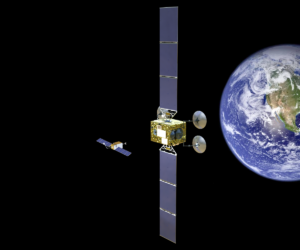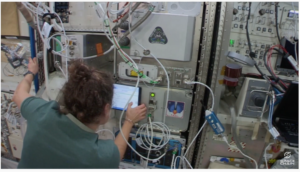China opens Shenzhou-12 return capsule at ceremony
Wednesday, 29 September 2021 06:21 China held a ceremony Monday to open the capsule of the Shenzhou-12 spacecraft which carried three astronauts back to Earth on Sept. 17.
Space officials, including Hao Chun, director of the China Manned Space Agency, and China's first astronaut Yang Liwei handed over the items taken out of the capsule to various representatives.
Hao said that the Shenzhou-12 crewed mission included m
China held a ceremony Monday to open the capsule of the Shenzhou-12 spacecraft which carried three astronauts back to Earth on Sept. 17.
Space officials, including Hao Chun, director of the China Manned Space Agency, and China's first astronaut Yang Liwei handed over the items taken out of the capsule to various representatives.
Hao said that the Shenzhou-12 crewed mission included m MDA releases first details of its next generation commercial earth observation mission
Wednesday, 29 September 2021 06:21 MDA Ltd has released new details about its next industry leading Earth observation (EO) mission. Leveraging legendary RADARSAT heritage, the new system will include a large C-band Synthetic Aperture Radar (SAR) satellite operating in a mid-inclination orbit. Capable of covering a 700 km swath in a single pass, the new system will provide the broadest area coverage on the market, changing how, wh
MDA Ltd has released new details about its next industry leading Earth observation (EO) mission. Leveraging legendary RADARSAT heritage, the new system will include a large C-band Synthetic Aperture Radar (SAR) satellite operating in a mid-inclination orbit. Capable of covering a 700 km swath in a single pass, the new system will provide the broadest area coverage on the market, changing how, wh Bare Super-Earths offer clues to evolution of hot atmospheres
Wednesday, 29 September 2021 06:21 A group of astronomers from the Astrobiology Center, the National Astronomical Observatory of Japan, the University of Tokyo, and other institutes, discovered two rocky super-Earth exoplanets lacking thick primordial atmospheres in very close orbits around two different red dwarf stars. These planets provide a chance to investigate the evolution of the atmospheres of hot rocky planets.
In
A group of astronomers from the Astrobiology Center, the National Astronomical Observatory of Japan, the University of Tokyo, and other institutes, discovered two rocky super-Earth exoplanets lacking thick primordial atmospheres in very close orbits around two different red dwarf stars. These planets provide a chance to investigate the evolution of the atmospheres of hot rocky planets.
In Spin test a success, but Ingenuity Flight 14 delayed until after conjunction
Wednesday, 29 September 2021 06:21 It's been an eventful several Martian days, or sols, since our last blog post, so we wanted to provide everyone with an update on where things stand on Mars. In our last post, we explained that we were getting ready to begin flying with a higher rotor speed to compensate for decreasing atmospheric density caused by seasonal changes on Mars.
Increasing the rotor speed is a significant chang
It's been an eventful several Martian days, or sols, since our last blog post, so we wanted to provide everyone with an update on where things stand on Mars. In our last post, we explained that we were getting ready to begin flying with a higher rotor speed to compensate for decreasing atmospheric density caused by seasonal changes on Mars.
Increasing the rotor speed is a significant chang Soyuz docks to new Nauka module port at ISS
Wednesday, 29 September 2021 06:21 The Soyuz MS-18 spacecraft that first launched and arrived to the International Space Station April 9 has now successfully relocated with its crew aboard from the station's Earth-facing Rassvet module to the "Nauka" Multipurpose Laboratory Module. The spacecraft carrying Russian cosmonauts Oleg Novitskiy, commander of the Soyuz, and Pyotr Dubrov along with NASA astronaut Mark Vande Hei, docked a
The Soyuz MS-18 spacecraft that first launched and arrived to the International Space Station April 9 has now successfully relocated with its crew aboard from the station's Earth-facing Rassvet module to the "Nauka" Multipurpose Laboratory Module. The spacecraft carrying Russian cosmonauts Oleg Novitskiy, commander of the Soyuz, and Pyotr Dubrov along with NASA astronaut Mark Vande Hei, docked a Asteroid sample brought back to Earth gets a close-up look at Brown
Wednesday, 29 September 2021 06:21 In December 2020, Japan's Hayabusa2 spacecraft swung by Earth to drop off a cache of rock samples taken from a near-Earth asteroid called Ryugu. Asteroids like Ryugu are thought to represent the ancient building blocks of the solar system, and scientists have been eager to get a closer look at the returned samples.
Last week, the Japanese Aerospace Exploration Agency shipped one of the sam
In December 2020, Japan's Hayabusa2 spacecraft swung by Earth to drop off a cache of rock samples taken from a near-Earth asteroid called Ryugu. Asteroids like Ryugu are thought to represent the ancient building blocks of the solar system, and scientists have been eager to get a closer look at the returned samples.
Last week, the Japanese Aerospace Exploration Agency shipped one of the sam Airbus backs Dereum Labs to collaborate on lunar resources extraction
Wednesday, 29 September 2021 06:21 Airbus has signed a memorandum of understanding with the Mexican Space Agency (AEM) and the Mexican start-up Dereum Labs to collaborate on the technologies needed for lunar resources extraction. This will lead to the creation of a new Mexican In-Situ Resources Utilisation (ISRU) Programme for lunar extraction and help develop the necessary industrial ecosystem for this technology in-country.
Airbus has signed a memorandum of understanding with the Mexican Space Agency (AEM) and the Mexican start-up Dereum Labs to collaborate on the technologies needed for lunar resources extraction. This will lead to the creation of a new Mexican In-Situ Resources Utilisation (ISRU) Programme for lunar extraction and help develop the necessary industrial ecosystem for this technology in-country. Isotropic Systems secures funding to develop multi-link antenna through to product launch in 2022
Wednesday, 29 September 2021 06:21 Isotropic Systems, a leading developer of transformational broadband terminal technologies, announces that it has raised over $37 million in an equity financing round, which fully funds the development of its game-changing multi-link antennas through to product launch in 2022.
The round is led by Seraphim Space Investment Trust PLC - the world's first listed space tech fund - in the first
Isotropic Systems, a leading developer of transformational broadband terminal technologies, announces that it has raised over $37 million in an equity financing round, which fully funds the development of its game-changing multi-link antennas through to product launch in 2022.
The round is led by Seraphim Space Investment Trust PLC - the world's first listed space tech fund - in the first NASA drought research shows value of both climate mitigation and adaptation
Wednesday, 29 September 2021 06:21 Seasonal summer rains have done little to offset drought conditions gripping the western United States, with California and Nevada seeing record July heat and moderate-to-exceptional drought according to the National Oceanic and Atmospheric Administration (NOAA). Now, new NASA research is showing how drought in the region is expected to change in the future, providing stakeholders with crucial i
Seasonal summer rains have done little to offset drought conditions gripping the western United States, with California and Nevada seeing record July heat and moderate-to-exceptional drought according to the National Oceanic and Atmospheric Administration (NOAA). Now, new NASA research is showing how drought in the region is expected to change in the future, providing stakeholders with crucial i China launches high-resolution Earth-observation satellite
Wednesday, 29 September 2021 06:21 China launched a Kuaizhou 1A carrier rocket to place a high-resolution Earth-observation satellite in space on Monday afternoon, according to China Aerospace Science and Industry Corporation.
The State-owned space contractor said in a statement the solid-propellant rocket blasted off at 2:19 pm at the Jiuquan Satellite Launch Center in northwestern China and soon deployed the satellite - J
China launched a Kuaizhou 1A carrier rocket to place a high-resolution Earth-observation satellite in space on Monday afternoon, according to China Aerospace Science and Industry Corporation.
The State-owned space contractor said in a statement the solid-propellant rocket blasted off at 2:19 pm at the Jiuquan Satellite Launch Center in northwestern China and soon deployed the satellite - J MIT professor: Interest in space careers at an all-time high
Tuesday, 28 September 2021 22:45
MIT’s Department of Aeronautics & Astronautics graduate admissions program this past year saw a record number of applicants, most of whom want to work in the space business.
Government shutdown could delay NASA’s Lucy asteroid mission
Tuesday, 28 September 2021 22:23
A NASA asteroid mission that has remained on schedule for a mid-October launch despite disruptions caused by the pandemic is now facing a new challenge: the threat of a federal government shutdown.
Panel: Orbital debris problem is a lot like trying to fix climate change
Tuesday, 28 September 2021 21:51
NASA advisor Bhavya Lal said the debris challenge is similar to the debate over how to addresss climate change.
Starfish Space raises $7 million for constellation-managing space tugs
Tuesday, 28 September 2021 19:58
Starfish Space has raised $7 million to develop space tugs that aim to extend the lives of satellites, move them to different orbits and remove debris.
Spire and SpaceChain announce on-orbit blockchain demonstration
Tuesday, 28 September 2021 19:05
Spire Global is working with SpaceChain, a company focused on space applications for blockchain technology, to demonstrate the technology in space and to highlight benefits and challenges.

